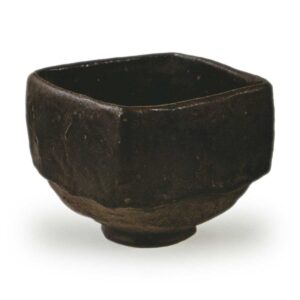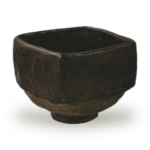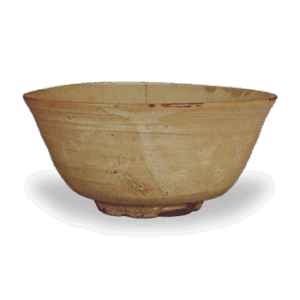

Height: 8.3-8.5cm
Diameter: 10.4-12.5cm
Outer diameter of foot ring: 4.9cm
Height of foot ring: 0.7cm
This tea bowl was passed down in the Chigusa-ya Hirase family of Osaka, along with the Chigusa Iroha, as something particularly treasured. As Nittai Kiriuchi wrote on the back of the lid of the paulownia wood box, “Chojiro Kuro Shiho Chawan Kakumei Mu As Nittaku-sai wrote on the back of the lid of the paulownia wood box, “Mukiguri, with accompanying letter, Sōtan (signature)”, it is likely that the name “Mukiguri” was given after the color of the glaze.
Therefore therefore, it is thought that it was probably called “Chojiro Shiho Kuro” until the Hara So period.
In addition, as it is also certified on the outside box lid as “Square, made by Chojiro, owned by Rikyu”, and on the outside box lid as “Rikyu-style Chojiro ware, Shiho Kuro tea bowl”, it is thought that it is acceptable to agree that this tea bowl was Rikyu’s favorite. , the square shape of the “Mukiguri” is exactly the same as the square tea bowls that Rikyu had made for him to use at tea ceremonies in his later years, and it is thought that this was probably his favorite tea bowl from around the same time as his earlier tea bowls in the Soeki style, such as the “Daikoku” and “Muichimono”.
The tea bowl is a variant of the Shiho shape, but it still has the dignified quality that was so much loved by Rikyu. The upper part of the bowl is shaped like a Shiho, but the lower part is the same as a regular round bowl, and the way the bowl is shaped from the waist to the foot is similar to the Ayame shape. The foot The foot ring is deeply carved, giving it a strong, clear appearance, and the helmet-shaped design in the center of the foot ring is also very serious. The inside of the front of the bowl is carved in four directions, and there are what look like fingerprints on the four corners, appearing in steps like the marks made by a potter’s wheel.
The overall appearance is rather thick, and the glaze is also thick, giving it a stately appearance. In particular, the glaze on the outside, on all four sides, seems to be even thicker, and shows signs of coarse craze. The glaze is the typical kasegyo glaze unique to Chojiro black. The black black glaze is changing like a hazy mist, and there are also holes of various sizes and shapes all over the surface. The clear scissors marks on one side are just as impressive as in the case of the Daikoku, and there are about five uneven marks on the foot ring.
In addition I have also seen a copy of a letter by Ichiryu, which was thought to be a copy of the “Mukiguri” tea bowl, and in the letter accompanying this tea bowl, there is a copy of Ichiryu’s notes, which read “This tea bowl was made by Chojiro for Lord Enshu. It is a small tea bowl with a square top and a round bottom. (small, square-shaped bowl with a round bottom) [illustration] It is said that the right one is for sale from the old man Yuukai Minami. It is written in the right-hand corner of the paper that “It is a copy of the letter written by Raku Kichizaemon.
Furthermore , this letter also tells us that it was in the possession of Goto Saburoemon during the Enshu period, and before that it was in the possession of “the old man from the south (is this a place name?)”, and before that it may have been in the possession of Rikyu. Goto Saburoemon was undoubtedly the ancestor of Goto Sōban (a student of Hara Sō), who sent the accompanying note “Hara Sō sent this Chōjirō black square tea bowl inscribed Mukiguri. This tea bowl is rare these days, so please keep it in your possession. (signature) Goto Sohan (the ancestor of Goto Sohan, a student of Hara Sohu), and it is thought that it was passed down from the Goto family to the Hirase family after that. It is not clear who Raku Kichizaemon was who sent the copy of the letter.
Hirase








